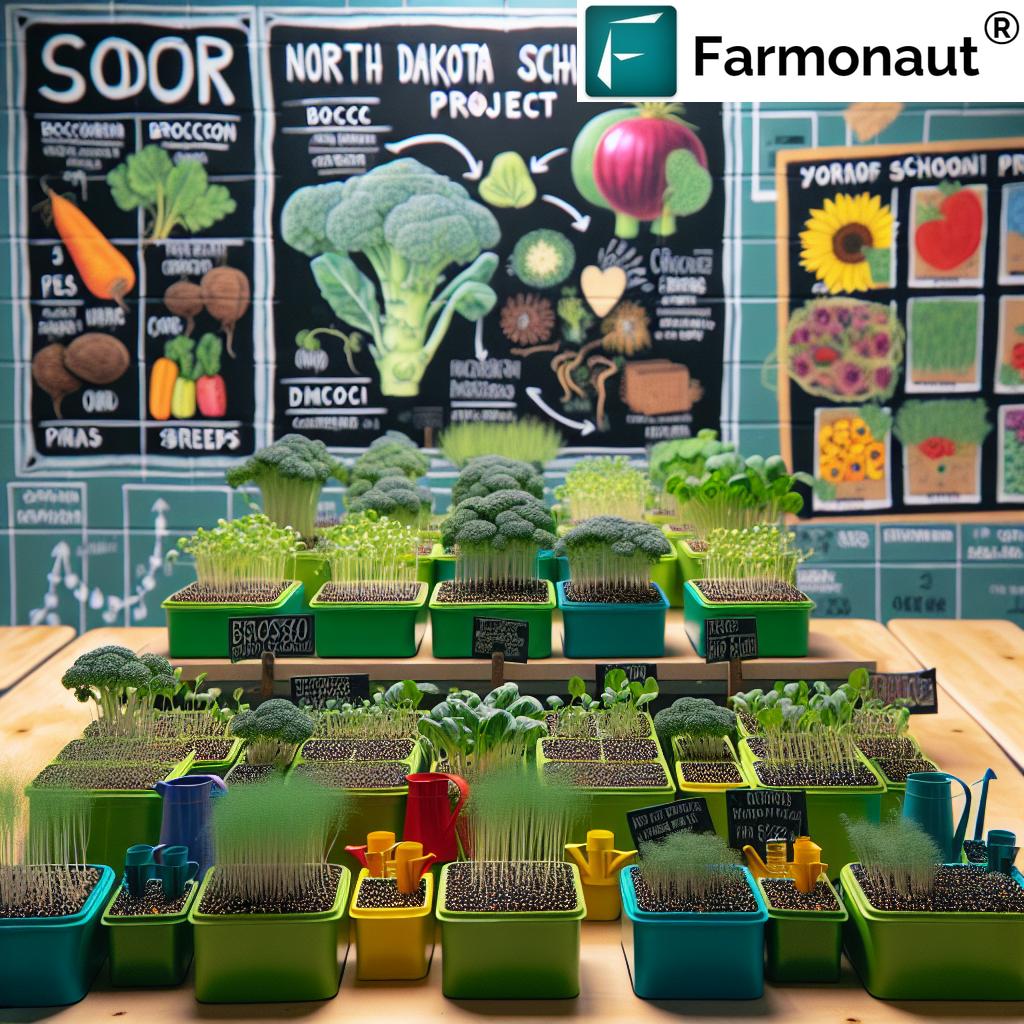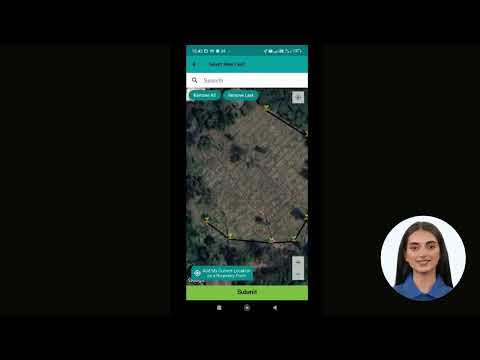Growing Green Minds: North Dakota Schools Cultivate Healthy Eating with Microgreens
“North Dakota elementary students grow microgreens like broccoli and peas in just 7-14 days, learning agriculture hands-on.”
In the heart of North Dakota, a green revolution is taking root in elementary classrooms. We’re witnessing an inspiring transformation as students trade textbooks for soil and seeds, embarking on a journey of discovery through the world of microgreens. This innovative approach to education is not just about growing plants; it’s about cultivating healthy minds and bodies, fostering a deep connection to agriculture, and planting the seeds of sustainable living.
Let’s dive into how these tiny greens are making a big impact on education and nutrition in North Dakota schools.
The Microgreen Movement in North Dakota Schools
In Glen Ullin, North Dakota, elementary students are getting their hands dirty for a good cause. They’re part of a growing movement that’s bringing agriculture right into the classroom through microgreens for kids programs. These young learners are not just observers; they’re active participants in the entire growing process, from preparing the soil to harvesting their very own crops.

The excitement is palpable as fourth-grader Daniel Martienz explains, “We’re watering it, putting the seeds in it.” This hands-on approach to learning is transforming how children view food and agriculture. By growing microgreens in schools, students are gaining firsthand experience with the life cycle of plants, understanding the care and attention required to nurture living things.
Why Microgreens? The Perfect Crop for Classroom Learning
Microgreens are an ideal choice for school gardening projects for several reasons:
- Quick Growth: Most microgreens are ready to harvest in just 7-14 days, perfect for maintaining student interest and fitting within lesson plans.
- Nutrient-Dense: These tiny plants pack a powerful nutritional punch, often containing higher concentrations of vitamins and minerals than their full-grown counterparts.
- Space-Efficient: Microgreens can be grown in small trays, making them suitable for classroom environments with limited space.
- Variety: From broccoli to peas, radishes to sunflowers, the diversity of microgreens allows for exciting experimentation and learning opportunities.
To better understand the characteristics of various microgreens commonly used in these educational programs, let’s take a look at this comparison table:
| Microgreen Type | Average Growth Time (days) | Nutrient Content | Ease of Growing (1-5) | Flavor Profile |
|---|---|---|---|---|
| Broccoli | 7-10 | High | 4 | Mild, slightly peppery |
| Peas | 8-12 | Medium | 5 | Sweet, fresh |
| Radish | 5-7 | High | 4 | Spicy, pungent |
| Sunflower | 10-14 | High | 3 | Nutty, slightly sweet |
| Kale | 8-12 | High | 4 | Mild, cabbage-like |
This table showcases the diversity and accessibility of microgreens, making them an excellent choice for elementary school garden programs.
The Educational Impact of Growing Microgreens
Teaching kids about agriculture through microgreens offers multifaceted learning opportunities:
- Science: Students observe germination, photosynthesis, and plant growth in real-time.
- Math: Measuring soil, water, and tracking growth rates incorporate practical math skills.
- Environmental Studies: Discussions on sustainable farming and local food production become tangible.
- Nutrition: Understanding the health benefits of fresh, locally grown food for children encourages better eating habits.
Jenna Nieters, a local foods marketing specialist with the N.D. Department of Agriculture, emphasizes, “When kids know where their food is grown, they’re so much more likely to be engaged and interested in it.” This engagement is key to fostering a lifelong interest in agriculture and healthy eating.
The Role of Technology in Modern Agricultural Education
While the Glen Ullin students are focusing on hands-on learning with microgreens, it’s worth noting how technology is enhancing agricultural education on a broader scale. Innovative platforms like Farmonaut are bringing advanced agricultural technologies into the classroom, offering students insights into precision farming techniques.
Farmonaut’s satellite-based crop health monitoring and AI advisory systems provide a glimpse into the future of agriculture, where data-driven decisions help farmers optimize yields and conserve resources. While not directly related to the microgreens project, such technologies complement hands-on learning by showing students the cutting-edge tools used in modern farming.
“Over 60% of students who participate in school gardening programs show increased interest in eating fruits and vegetables.”
Nurturing Healthy Eating Habits
One of the most significant benefits of growing microgreens in schools is its impact on students’ eating habits. Amanda Olson, a farm-to-school specialist with the N.D. Department of Public Instruction, notes, “It’s so fun to see their hands just get a little dirty. It just really clicks for them.” This physical connection to food production often translates into a greater willingness to try new, healthy foods.
The North Dakota Ag Department’s initiative aligns perfectly with the goal of encouraging children to make healthier food choices. By growing their own microgreens, students develop a sense of ownership and pride in their produce, making them more likely to incorporate these nutrient-rich plants into their diets.

The Power of Microgreen Growing Kits
The success of the Glen Ullin program is largely due to the accessibility of microgreen growing kits provided through a state grant. These kits include everything needed to start a small-scale microgreen garden:
- Trays for planting
- High-quality soil
- A variety of microgreen seeds
- Instructions for planting and care
- Educational materials on nutrition and agriculture
The simplicity of these kits makes it easy for teachers to implement plant-based education in their classrooms, regardless of their gardening experience. This accessibility is crucial for widespread adoption of such programs across North Dakota schools and beyond.
Expanding the Reach: From Classrooms to Communities
The impact of these microgreen programs extends far beyond the classroom walls. As students share their experiences and harvests with family and friends, the enthusiasm for locally grown, nutritious foods spreads throughout the community. This ripple effect contributes to a broader awareness of the importance of sustainable agriculture and healthy eating habits.
Moreover, the skills and knowledge gained through these hands-on learning with plants experiences can inspire future career paths in agriculture, nutrition, and environmental sciences. By fostering a connection to food production at a young age, we’re nurturing the next generation of farmers, agronomists, and food scientists.
The Future of Microgreens in Education
The success of the microgreens program in Glen Ullin is just the beginning. The North Dakota Department of Agriculture received 76 applications for their 50 available kits this spring, indicating a strong interest in expanding these initiatives. Looking ahead, there are plans to introduce more diverse crops and extended growing projects to schools across the state.
As we consider the future of agricultural education, it’s exciting to imagine how technologies like those offered by Farmonaut could further enhance these programs. While the current focus is on small-scale microgreen production, future iterations might incorporate:
- Virtual farm tours using satellite imagery
- Data analysis projects using real-time crop health information
- Comparative studies of traditional and precision farming techniques
These advancements could bridge the gap between small-scale classroom projects and the realities of modern, large-scale agriculture, providing students with a comprehensive understanding of the food production system.
Challenges and Opportunities
While the benefits of growing microgreens in schools are clear, there are challenges to implementing and sustaining these programs:
- Funding: Securing ongoing funding for supplies and equipment can be difficult for some schools.
- Time Constraints: Integrating gardening activities into already packed curricula requires careful planning.
- Maintenance: Ensuring proper care of the plants during weekends and school breaks can be challenging.
- Teacher Training: Providing educators with the necessary skills and knowledge to lead these projects effectively.
However, these challenges also present opportunities for community involvement and creative problem-solving. Local businesses, gardening clubs, and agricultural organizations can partner with schools to provide resources, expertise, and volunteer support.
The Broader Impact on Sustainable Agriculture
As we nurture young minds through microgreen cultivation, we’re also contributing to a larger conversation about sustainable agriculture and food security. These school programs align with global efforts to promote:
- Local food production
- Reduced food miles
- Sustainable farming practices
- Improved nutrition and food literacy
By introducing these concepts at an early age, we’re laying the groundwork for a more sustainable and health-conscious society. The skills and awareness developed through these programs can contribute to more informed consumer choices and support for sustainable agricultural practices in the future.
Integrating Technology for Enhanced Learning
While the focus of the North Dakota schools’ microgreens program is on hands-on learning, there’s potential to integrate technology for enhanced educational experiences. For instance, platforms like Farmonaut, which offer crop plantation and forest advisory services, could provide students with insights into large-scale agricultural operations.
Imagine students using satellite imagery to compare their small microgreen plots with vast fields of crops, learning about the challenges and solutions in modern farming. This integration of technology could bridge the gap between small-scale classroom projects and the realities of commercial agriculture.
Community Engagement and Partnerships
The success of microgreens programs in schools often relies on strong community support and partnerships. Local farmers, gardening clubs, and agricultural businesses can play crucial roles in:
- Providing expertise and guest lectures
- Donating supplies or additional growing equipment
- Offering field trip opportunities to working farms
- Mentoring students interested in agricultural careers
These partnerships not only enrich the educational experience but also strengthen the connection between schools and their local agricultural communities.
Measuring Success: Beyond the Classroom
To truly understand the impact of microgreens programs, it’s important to look beyond immediate classroom engagement. Long-term success metrics might include:
- Changes in students’ eating habits and preferences for fresh vegetables
- Increased awareness and interest in agricultural careers
- Improvements in science and math scores related to hands-on learning experiences
- Community-wide shifts towards more sustainable and local food choices
Tracking these outcomes over time can provide valuable insights into the far-reaching benefits of integrating agriculture into education.
Expanding the Vision: From Microgreens to Sustainable Communities
As we look to the future, the potential for expanding these educational initiatives is vast. The skills and knowledge gained through microgreens programs can serve as a foundation for broader sustainability education. Future developments might include:
- School-wide composting programs
- Larger school gardens or greenhouses
- Farm-to-school lunch programs featuring student-grown produce
- Community outreach projects to share knowledge and harvests
By scaling up these initiatives, schools can become hubs of sustainable practices, influencing not just students but entire communities.
Conclusion: Nurturing a Greener Future
The microgreens program in North Dakota schools is more than just a gardening project; it’s a seed of change planted in the fertile minds of young learners. By combining hands-on experience with educational insights, we’re cultivating a generation that understands the importance of sustainable agriculture, healthy eating, and environmental stewardship.
As these programs continue to grow and evolve, incorporating new technologies and expanding their reach, we can look forward to a future where the connection between farm and table is understood and valued by all. The young hands planting microgreens today are the same hands that will shape our agricultural future tomorrow.
Let’s continue to support and expand these initiatives, ensuring that every child has the opportunity to experience the wonder of growing their own food and the knowledge to make informed, healthy choices throughout their lives.
FAQs
- What are microgreens?
Microgreens are young vegetable greens that are approximately 1–3 inches tall. They have an aromatic flavor and concentrated nutrient content and come in a variety of colors and textures. - Why are microgreens good for school projects?
Microgreens are ideal for school projects because they grow quickly (7-14 days), require little space, and offer hands-on learning opportunities in science, nutrition, and agriculture. - How do microgreens benefit children’s health?
Microgreens are packed with nutrients, often containing higher levels of vitamins and minerals than their mature counterparts. They can encourage children to eat more vegetables and develop healthier eating habits. - Can microgreens be grown year-round in schools?
Yes, microgreens can be grown indoors year-round, making them perfect for continuous learning regardless of the season or climate. - How can parents support microgreen programs at home?
Parents can support these programs by growing microgreens at home, incorporating them into family meals, and discussing the importance of healthy eating and sustainable agriculture with their children.
Earn With Farmonaut: Earn 20% recurring commission with Farmonaut’s affiliate program by sharing your promo code and helping farmers save 10%. Onboard 10 Elite farmers monthly to earn a minimum of $148,000 annually—start now and grow your income!




















